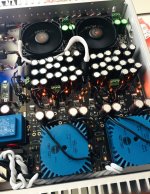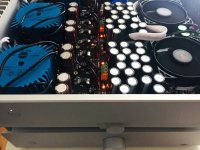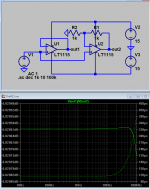Nice work Idiosyncrasy!

The “choir” comment was aimed at discrete output transistors. It’s a real effect - that’s why we have load sharing resistors to take up the small differences. If totally unmatched, even load sharing resistors can’t help.
With opamps in a buffer config, each one has local feedback to make it match its neighbors. But one thing to consider is that a feedback free amp sounds better from an imaging standpoint - phase is very flat and with great margin. Listen to a single opamp based amp and then 40 in parallel - with tracks that rely on stereo imaging. Now you have 40 feedback loops going on. See in your minds eye which is better or more clear.

The “choir” comment was aimed at discrete output transistors. It’s a real effect - that’s why we have load sharing resistors to take up the small differences. If totally unmatched, even load sharing resistors can’t help.
With opamps in a buffer config, each one has local feedback to make it match its neighbors. But one thing to consider is that a feedback free amp sounds better from an imaging standpoint - phase is very flat and with great margin. Listen to a single opamp based amp and then 40 in parallel - with tracks that rely on stereo imaging. Now you have 40 feedback loops going on. See in your minds eye which is better or more clear.
listening with your imagination does give 'different' results from 'ears only'
of course you can inform your imagination
try comparing unity gain vs 2x gain with fast opamps for difference in group delay, essentailly the same as batch GBW variation of 2:1
result: ~ 130 ps @ 20 KHz - yes that's picoseconds
Listen to a single opamp based amp and then 40 in parallel - with tracks that rely on stereo imaging. Now you have 40 feedback loops going on. See in your minds eye which is better or more clear.
of course you can inform your imagination
try comparing unity gain vs 2x gain with fast opamps for difference in group delay, essentailly the same as batch GBW variation of 2:1
result: ~ 130 ps @ 20 KHz - yes that's picoseconds
Attachments
JCX,
That’s cool if you don’t believe ZGF amps make a difference in imaging. It makes a difference for live recorded minimally produced ambient music. I don’t want to clog up this thread with that debate. It’s in a way similar to people who argue that speakers without transient perfect response crossovers are indistinguishable from those that are because they think LR2 XO’s sound fine with a tweeter signal that’s 180deg out of phase. It’s the most popular XO in multi ways.
That’s cool if you don’t believe ZGF amps make a difference in imaging. It makes a difference for live recorded minimally produced ambient music. I don’t want to clog up this thread with that debate. It’s in a way similar to people who argue that speakers without transient perfect response crossovers are indistinguishable from those that are because they think LR2 XO’s sound fine with a tweeter signal that’s 180deg out of phase. It’s the most popular XO in multi ways.
Last edited:
Utter nonsense. Doug Self is not The guru of Audio design nor is Nelson Pass. But I must admit his Camp Amp with lateral MOSFETS is very good indeed. Especially when driven by a EF86 pentode configured as a triode with an MJE340 buffer transistor for 0.003% distortion. Maybe you like Opamp sound I don't. In my opinion the best web site I have found is Elliot Sound Products.
Any literature on this? I can't find anyThe “choir” comment was aimed at discrete output transistors. It’s a real effect - that’s why we have load sharing resistors to take up the small differences. If totally unmatched, even load sharing resistors can’t help.
Hey 70s Veteran, can you post a schematic of the triode/MJE340 circuit? I have a couple of Amp Camp boards that I haven't used yet. Been thinking of a project with them and would love to see your ideas.
Each of the 80 op-amps in a channel is different. If they were all exactly the same then there would still be variance in resistor values, connection trace resistances and reactances, and noise. Any individual op-amp output target voltage that's different from the average (sort of average) of the herd will be driven into a 1 ohm resistor. How large are these differential currents likely to be when playing music?
Any individual op-amp output target voltage that's different from the average (sort of average) of the herd will be driven into a 1 ohm resistor. How large are these differential currents likely to be when playing music?
Each opamp will also sink the error voltage any opamp produces, so paralleling a million should create quite good average. Starting from 80 for example.
Finishing things up properly
After going through a couple of iterations for the power supply for this amplifier, I finally managed to finish this project. I re-used the aluminum enclosure my previous amplifier resided in to house this new one (it's originally an HTPC computer case).
Anyway, here are a couple of pics showing the end result:


The 90mm fans can be controlled dynamically using a temperature sensor mounted underneath the op amp array.
I'm quite happy with how this build turned out; thanks again to D. Self for the inspiration!
After going through a couple of iterations for the power supply for this amplifier, I finally managed to finish this project. I re-used the aluminum enclosure my previous amplifier resided in to house this new one (it's originally an HTPC computer case).
Anyway, here are a couple of pics showing the end result:


The 90mm fans can be controlled dynamically using a temperature sensor mounted underneath the op amp array.
I'm quite happy with how this build turned out; thanks again to D. Self for the inspiration!
Each opamp will also sink the error voltage any opamp produces, so paralleling a million should create quite good average. Starting from 80 for example.
Unfortunately, all these error currents eat into your output current budget, so the overall output power is less than you'd think. I've also seen such error currents wreck the THD of a parallel amp, so it usually pays to minimize the offset first, then put the amps in parallel.
Tom
I've also seen such error currents wreck the THD of a parallel amp, so it usually pays to minimize the offset first, then put the amps in parallel.
How big were the offets in the case you’re describing, Tom?
Any updates?
Well, it's been in use as my main amp for the past one year and a half or so!
I'm more than happy with the end result. It looks good and sounds even better. Some follow-up measurements I did late last year show that the objective performance is excellent as well, e.g., the THD+N is around -120dB or lower. I'd like to measure it more precisely, but-this being a hobby and all-I'm hesitant to invest thousands of euros or dollars in high-end measurement gear. 😉
Currently, I'm building an ES9038PRO-based DAC to go along with this puppy.
Thanks for your interest. However, I don’t plan on offering the boards and only had a few made in the first place—they’re relatively lage, high-quality, 4-layer PCBs and as such very costly. Plenty of great alternatives on these forums though!Any plans to offer the boards?
Hello! Could you connect several of these to achieve greater power per channel? If so, how would I do it?
Coro 48 NE5532 * 24 ultra baja distorsion 24W Amplificador Board para auriculares estereo | eBay
I also have two of these ... could I use the 24 operational amplifiers as a single block?:
NE5532 * 24 ultra baja distorsion 12W*2 Auriculares Estereo Amplificador Board Para Estereo | eBay
Greetings and thank you very much in advance
Coro 48 NE5532 * 24 ultra baja distorsion 24W Amplificador Board para auriculares estereo | eBay
I also have two of these ... could I use the 24 operational amplifiers as a single block?:
NE5532 * 24 ultra baja distorsion 12W*2 Auriculares Estereo Amplificador Board Para Estereo | eBay
Greetings and thank you very much in advance
Hello! Could you connect several of these to achieve greater power per channel? If so, how would I do it?
Coro 48 NE5532 * 24 ultra baja distorsion 24W Amplificador Board para auriculares estereo | eBay
I also have two of these ... could I use the 24 operational amplifiers as a single block?:
NE5532 * 24 ultra baja distorsion 12W*2 Auriculares Estereo Amplificador Board Para Estereo | eBay
Greetings and thank you very much in advance
No, firstly you need 32 dual opamps at least per section to drive 8 ohm at full swing which is only 15W, not 24W.... If you need more power you have to bridge, which needs twice as many opamps in each amp for a total of 4 x 64 = 256, so you'd need different boards. I suppose you could combine several of those boards with very low value power resistors to up the current handling, but the initial gain stages need to be very accurately matched.
I could change the resistors so that they are at least 0.1% and join several of those plates thank you very much for the answer!
No, firstly you need 32 dual opamps at least per section to drive 8 ohm at full swing which is only 15W, not 24W.... If you need more power you have to bridge, which needs twice as many opamps in each amp for a total of 4 x 64 = 256, [..]
Exactly, so while it is possible, if you need the added power, it'd probably be a better idea to go with a composite amplifier design, like the one jcx linked to earlier on in this thread.
You should first check, however, if you indeed need that much power. My floorstanding speakers are quite sensitive and at max level this amp is already shaking the room. 😀
- Home
- Amplifiers
- Chip Amps
- Building a massively parallel op amp power amplifier
